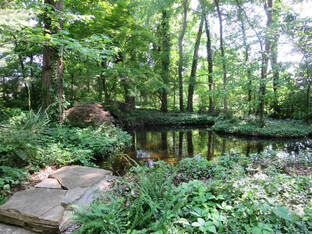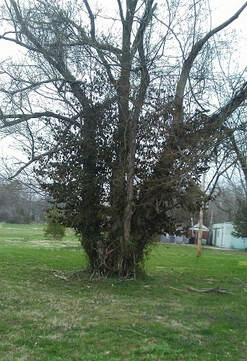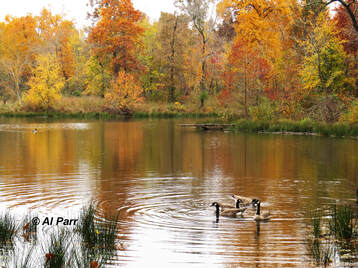Mike Baltz's New Article on Fighting Invasive Species
(from the Carbondale Times)
Alien Invasion
I’ve worked over the years to create a little Homegrown Park on the little bit of land in front of
and behind my house. I’ve transplanted native trees and flowering plants and let parts of my
front and backyards just grow wild.
My goal is to have less lawn to mow every year until I can essentially retire my mower.
In order to get an idea of the plant diversity in my Park, I asked botanist Chris Benda to do a
quick plant inventory of my front and back yards. And in less than an hour, Chris identified over
100 plant species, including 26 different kinds of trees.
Some of the native tree species in my Park include Tulip Poplar, Bald Cypress, Dogwood, Sweet
Gum, Eastern Redbud, Green Ash, and Sugar Maple. I was pleasantly surprised to find out that I
also had some little persimmon trees trying to get above the browse-line of the white-tail deer
that are common visitors in my Park.
But in addition to many cool native species, 30% of the plant species that Chris identified were
nonnatives.
By definition, non-native species are just organisms that don’t occur naturally in an area. So, the
short-leaf pine trees that I have transplanted are technically non-native because Southern Illinois
is just beyond their range.
Common dandelions and white clover are also nonnative species. They are native to Europe,
were introduced by settlers as food and forage, and only occur in disturbed areas, like fields and
lawns.
Some non-native species, however, merit the term ‘invasive’. Invasive species are a problem
because they can prevent or hinder the survival of other native species in an ecosystem.
The worst invasive plant species can literally take-over habitats. For example, Garlic mustard, an
invasive species in Southern Illinois, spreads quickly on the forest floor and exudes chemicals
that prevent other native plant species from growing around it.
Unfortunately, I have several nasty invasive species in my Park including Oriental Bittersweet,
Bush Honeysuckle, and Japanese Stiltgrass. These three species especially can become problems
in our Southern Illinois oak forest ecosystems.
Because controlling invasive species often requires the application of herbicide, it is ideal to
have professional help when addressing an invasive species problem, and thankfully, Keep
Carbondale Beautiful and the local Forest Resource Support Team (FRST) have recently
partnered to begin helping private landowners with invasive species problems.
Anne Krippenstapel, executive director of Keep Carbondale Beautiful, says, “I see many private
properties that are sanctuaries for invasive species that then infest wild public lands. If we can do
something within the city limits, a little bit of work, and a lot of education, maybe we can reduce
the threat to public lands.”
Krippenstapel, Isaiah Tanner (FRST coordinator), and two volunteers were able to come by my
house on July 30 as part of a recent ‘invasive roundup’, that included two other private properties
in the Carbondale area.
The group made quick work of some bush honeysuckle, using a small chainsaw on some of the
bigger shrubs. They also applied a foliar spray to a couple patches of stiltgrass and bittersweet.
In return for their work, I provided the group with two blackberry custard pies!
While my invasive species problem isn’t going away, thanks to Keep Carbondale Beautiful and
FRST, we addressed some of the worst offenders and I learned a lot about how to be a better
steward of my Homegrown Park.
(Visit KeepCB.org and FRSTIllionois.com for more information about these groups. For more
information about invasive species in Southern Illinois visit the River-to-River Cooperative
Weed Management Area website, rtrcwma.org)
BeautificationBeautification makes Carbondale more welcoming to prospective home-buyers and businesses and is a sign of economic well-being. Keep Carbondale Beautiful actively encourages beautification of residences and businesses through the Bright Spot Award and by providing native trees and shrubs at our Tree Sale. Even if a city is entirely functional and livable, there is always something additional to be gained when efforts are taken to enhance aesthetic value through buildings that enhance neighborhood pride and through well-maintained greenery.
Ongoing Projects |
Garden Tours
We will try to host another garden tour in June 2020. Please send us your nominations for beautiful gardens in Carbondale, or other ideas. In 2017 we toured the chicken coops! How about compost piles next time? The tour will be self-guided. Participants can drive or even bicycle to all the gardens. Gardener(s) will be on site to answer questions. |
Other Projects
|
Saving Trees from Winter Creeper
Do you have a tree that looks like this? With invasive winter creeper (Euonymus fortunei) crawling up the trunk, where it will then flower and reproduce? If you want to protect that tree, the vine should be cut at the base of the tree and possibly torn out by the roots (the vine on the bark will die and fall off). Keep Carbondale Beautiful partnered with the Agricultural Student Advisory Council to save trees from winter creeper. If you'd still like help or would like to report a tree, please contact us at 618-525-5525 or [email protected]. Provide address, name, and phone number of home-owner or person in authority who is giving permission.
Public Forum:
|
Carbondale's Most Beautiful Spot
When was the last time you walked the trail at Campus Lake? Do it again! Introduce a new friend to Carbondale's most beautiful spot.
Besides Campus Lake, votes for “most beautiful spot” were cast for Longbranch Café’s terrace, Castle Park (Jeremy ‘Boo’ Rochman Memorial Park), Rothrock Prairie (Green Earth’s North Oakland Nature Preserve), and the Labyrinth Peace Garden at Gaia House. The Labyrinth and Longbranch have both been recognized in the past with Bright Spot Awards. Planting TreesEach year, KCB devotes a chunk of its grant money to planting more trees along the streets of Carbondale. According to James Howard Kunstler, there are four functions of street trees:
Each spring and fall we hold a tree and shrub sale. And in 2020 we'll be bringing back the Champion Tree Contest as part of a year-long campaign to promote trees as a way to combat climate change. Did you know that the City of Carbondale will plant a tree on your property? Learn more. Alternatives to Lawns
Our Alternatives to Lawns workshop was held on July 30, 2016 and included various approaches to convert from grass lawns. |



